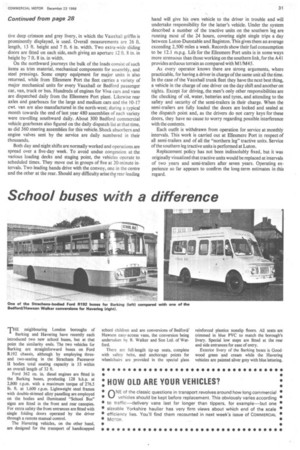School buses with a difference
Page 33

If you've noticed an error in this article please click here to report it so we can fix it.
THE neighbouring London boroughs of
Barking and Havering have recently each introduced two new school buses, but at that point the similarity ends. The two vehicles for Barking are straightforward buses on Ford R192 chassis, although by employing threeand two-seating in the Strachans Pacesaver II bodies total seating capacity is 53 within an overall length of 32 ft.
Ford 362 cu. in. diesel engines are fitted in the Barking buses, producing 128 b.h.p. at 2,800 r.p.m. with a maximum torque of 276.5 lb. ft. at 1,600 r.p.m. Lightweight steel frames with double-skinned alloy panelling are employed on the bodies and illuminated "School Bus" signs are fitted in the front and rear canopies. For extra safety the front entrances are fitted with single folding doors operated by the driver through a remote manual control.
The Havering vehicles, on the other hand, are designed for the transport of handicapped
school children and are conversions of Bedford/ Hawson easy-access vans, the conversion being undertaken by B. Walker and Son Ltd. of Watford.
There are full-length tip-up seats, complete with safety belts, and anchorage points for wheelchairs are provided in the special glass
reinforced plastics nonslip floors. All seats are trimmed in blue PVC to match the borough's livery. Special low steps are fitted at the rear and side entrances for ease of entry.
Exterior livery of the Barking buses is Goodwood green and cream while the Havering vehicles are painted silver grey with blue lettering.












































































